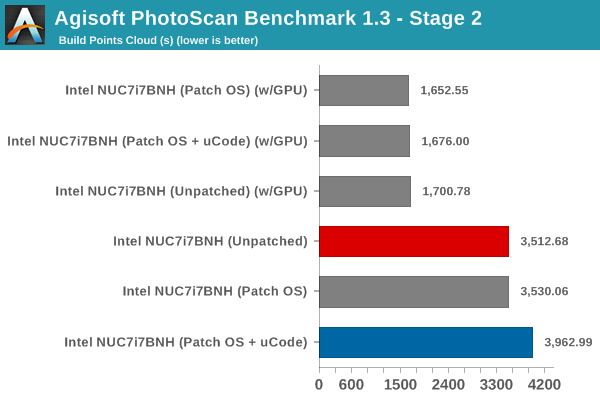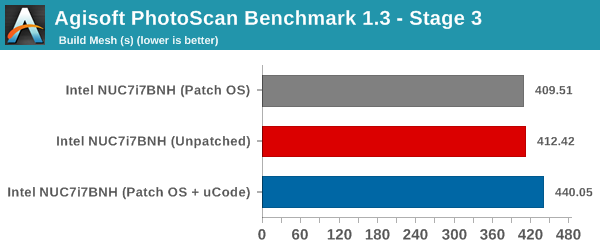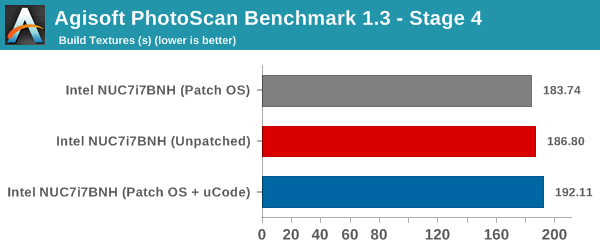Meltdown & Spectre: Analyzing Performance Impacts on Intel's NUC7i7BNH
by Ganesh T S on March 23, 2018 4:15 PM EST- Posted in
- Systems
- Spectre
- Benchmarks
- Meltdown
Miscellaneous Benchmarks
CINEBENCH R15 is our benchmark of choice for 3D rendering. It provides three benchmark modes - OpenGL, single threaded and multi-threaded. This benchmark is largely unaffected by the patching. All the recorded numbers are within the margin of expected errors from one run to another.



x264 v5.0 is another benchmark that is unaffected by the Meltdown and Spectre patches.


7-Zip is a very effective and efficient compression program, often beating out OpenCL accelerated commercial programs in benchmarks even while using just the CPU power. 7-Zip has a benchmarking program that provides tons of details regarding the underlying CPU's efficiency. In our benchmark suite, we are interested in the compression and decompression MIPS ratings when utilizing all the available threads. This benchmark also remains unaffected, with the results happening to be within the margin of error from run to run.


Agisoft PhotoScan is a commercial program that converts 2D images into 3D point maps, meshes and textures. The program designers sent us a command line version in order to evaluate the efficiency of various systems that go under our review scanner. The command line version has two benchmark modes, one using the CPU and the other using both the CPU and GPU (via OpenCL). We have been using an old version of the program with 50 photographs in our reviews till now. The updated benchmark (v1.3) now takes around 84 photographs and does four stages of computation:
- Stage 1: Align Photographs (capable of OpenCL acceleration)
- Stage 2: Build Point Cloud (capable of OpenCL acceleration)
- Stage 3: Build Mesh
- Stage 4: Build Textures
We record the time taken for each stage. Since various elements of the software are single threaded, others multithreaded, and some use GPUs, it is a very relevant benchmark from a media editing and content creation perspective.




Since this is a real-world benchmark, we can see performance impacts in some of the stages. While the first and last ones do not have any significant deviation, stages 2 and 3 are worse off by around 12.8% and 6.8% respectively in the non-GPU case.
The benchmarks section wraps up with the new Dolphin Emulator (v5) benchmark mode results. This is again a test of the CPU capabilities, but, we don't see much impact on the performance from the patching. The bennchmark consistently took around 325 seconds in all three patching configurations.










83 Comments
View All Comments
Klimax - Sunday, March 25, 2018 - link
Just well chosen set of likely badly written projects to get wanted conclusion...ZolaIII - Sunday, March 25, 2018 - link
What isn't correct there? Why don't you write better one's as source is there? The general tests as SQL, web serving or Github init create & compile times are among many real use & not synthetic benchmarks. You may not find those crucial on standard desktop, on workstation and small server they are & OS choose dictated upon them & system purpose on large server space you won't find anything called Windows there even M$ embraced Linux there (Azure platform).Now try to explain what is your so called "wanted conclusion"? While Linux makes his small talks how he still isn't satisfied with fixes person mostly struck with the regressions & solely most responsible one for the getting Linux to performance leading platform & on much more architectures than any other OS ever supported is Peter Zijlstra.
Now buzz off!
ZolaIII - Sunday, March 25, 2018 - link
Linus*nismotigerwvu - Friday, March 23, 2018 - link
Wow, it looks like this puts Intel behind AMD on IPC for the first time since 2006, at least until new SKUs come to market.mkaibear - Saturday, March 24, 2018 - link
Nah, Zen was about 7% behind on IPC on average, this gets AMD closer but not quite there yet.Means picking a system based on use case has got more interesting though.
Klimax - Sunday, March 25, 2018 - link
Since AMD doesn't have patch for Specters ready, such conclusion is not warranted yet.phoenix_rizzen - Friday, March 23, 2018 - link
Are the OS patch levels listed correct?.125 is unpatched.
.309 is Meltdown-only patched.
.214 is both patched.
Should that last one be .314?
ganeshts - Saturday, March 24, 2018 - link
Initially, I wanted to present only the unpatched and fully patched results.Unfortunately, I have a number of PCs pending review that don't seem to be receiving BIOS updates anytime soon (despite Intel having released the final microcode for its patching). Hence, I had to add the OS-patch only scenario at the last minute after rolling back the BIOS.
So, the order of testing was :
1. Unpatched
2. Both Patched
3. Only OS patched
Drazick - Saturday, March 24, 2018 - link
How did you make your system unpatched?Ryan Smith - Saturday, March 24, 2018 - link
There are registry settings available in Windows to turn off the OS patches. Steve Gibson's InSpectre can twiddle the necessary bits rather easily: https://www.grc.com/inspectre.htm